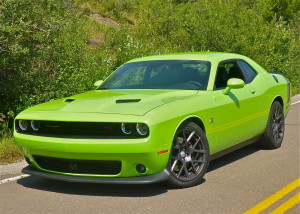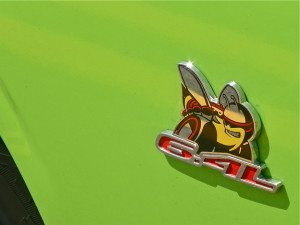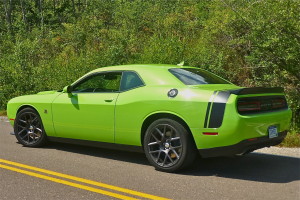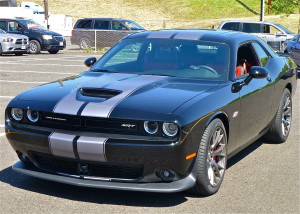New Challenger Power: Excessively Sublime
By John Gilbert
If you can’t tell by the “Sublime” paint job that is close to glow-in-the-dark green, then the little Superbee medallion on both flanks of the 2015 Dodge Challenger should put you on full alert: The Ponycar War just escalated.
The big news in the hot, fun, halo performance-car segment is that the new Mustang will be thoroughly restyled for 2015 with independent rear suspension and a high-tech EcoBoost engine option, plus a Shelby GT500 model with 500 horsepower, while Chevrolet is countering by blessing the new Camaro with a Corvette engine option with 505 horsepower as the $75,000 Z-28. What could Dodge do with its 2015 Challenger to avoid being left behind — literally and figuratively?
Plenty, as it turns out. Faced with higher stakes in the three-ponycar battle, which began back around 1970 when they were the stalwart performers in the Trans-Am road-racing series, the rejuvenated Chrysler group dedicated Dodge as its high-performance weapon, and Dodge engineers came through with bone-jarring power combined with clever technology to send the new Challenger off to battle well-armed. Speaking of the small group called “standard specialty segment,” and which I call future-retro ponycars, many might think it consists only of expensive toys, with rear-wheel drive that negates a lot of winter-driving use.
But consider that the segment sold 430,000 units last year, which is 10 percent more than in 2009, and it is projected to grow 42 percent in the next five years. The Challenger was reintroduced five years ago, and while its sales doubled from 2009-2013, it set a sales record last year, when it should have been fading as a fifth year vehicle. The new car should render all current records obsolete.
To the uninitiated, the new Challenger won’t look all that different from the current Challenger. But to the discerning eye, the revised grille and other subtle touches are remindful of the 1971 Challenger, but even at the height of muscle cars, no ponycar — and no hot sedan, for that matter — has had what lurks under the hood of the new Challenger. For openers, the Challenger starts with the very competent 3.6-liter V6, and steps up to the 5.7-liter Hemi V8, which takes the V6‘s 305 horsepower up to 375, coupled with 410 foot-pounds of torque in a stick-shift R/T version.
Leaping above the R/T is the R/T Plus, with a 6.4-liter Scat Pack model, which has 485 horsepower and 475 foot-pounds of torque through a six-speed manual or eight-speed automatic. That’s the one with the Superbee festooned to the sides, that cartoon symbol of Dodge and Plymouth power from over 40 years ago. Ah, but that’s not all. Remember, the new Mustang’s Shelby version is rumored to be about 500 horsepower, and Motor Trend did a cover story on the Z-28 Camaro, claiming 505 horsepower and 481 foot-pounds of torque. Dodge’s SRT — for Street and Racing Technology — high-performance team had a loftier objective: 700 horsepower.
They made it, with some to spare. They came up with a 6.2-liter Hemi V8, reinforced every component, and chose not to use direct injection, because forced injection was determined to be better for this project. They fitted a twin-screw supercharger on top to blast an air-fuel mixture into the cylinders and ultimately achieveed an incredible 707 horsepower, with 650 foot-pounds of torque. That engine comes in the top-performing package, which will be called the Hellcat, and we can expect it to rip off 0-60 times of around 4 seconds.
At the new Challenger introduction, in Portland, Ore., we got the chance to drive the Hellcat at Portland International Raceway. It was, as expected, a monster of pure power, but it was also surprisingly refined, in a way that Dodge and Chrysler have been able to master ever since Fiat took over control of Chrysler LLC. We will delve more deeply into the Hellcat’s performance in a few weeks, when I’m scheduled to get one for a week-long road test. For now, trust me that when Dodge engineers got SAE sanctioning for the 707 horsepower, it actually was a conservative number. The engine produces enough power to cover the 707 figure plus an additional dose to account for the full 80 horsepower it takes to run the supercharger, which spins up to 14,600 RPM when whirling to cram the maximum airflow into the engine.
The Hellcat engine required numerous special modifications, of course, and one of the special items for this future-retro gem is a twin key-fob plan. Use the red fob and you get the full 707 horsepower; use the black fob and RPMs are limited to 4,000 and horsepower is restricted to 500. So dads can feel a little comfortable when junior asks to use the car, and the black key should keep things under control.
As someone who was an intense fan of those Trans-Am racing days, and all the ponycars that competed, I’ve retained a fondness for those survivors still in existence today. The Mustang never went away, while the Camaro and Challenger did join the Barracuda, Firebird, and Javelin to disappear during the first energy crunch cutbacks in power. When the Camaro and Challenger returned to rejoin the Mustang in the marketplace, there are those Ford and Chevy fans who line up behind their favorites, but some of the more objective observers readily claim that the Challenger has remained the truest to its roots. Me? I like all three.
Meanwhile, back to that Sublime Scat Pack model, which I recently did live with for a week recently. In Duluth, Minnesota, park the new Challenger near a restaurant and sit inside to observe. Cars made u-turns to come back, park, climb out and snap off repeated cell-phone photos of the car. The bright, lime-green paint job, with what is actually a tasteful addition of a couple vertical black stripes at the rear, attracts a lot of attention. But so did the little Superbee emblem.
One advantage the Challenger has against the Mustang and Camaro is that the rear seat is actually inhabitable by real people with real legs, feet, and heads. It is called a 5-passenger, meaning three can sit in the rear. Most will appreciate the chance to sit inside this beast. And what a ride it will be.
The 6.4 Scat Pack has a 6-speed stick built by Tremec for standard equipment, and the 8-speed automatic is available as the TorqueFlite, a large improvement over the car’s 5-speed predecessor. Restraint is required because even with “only” 485 horsepower and 475 foot-pounds of torque, the 6.4 Scat Pack will go 0-60 in the mid-4-second range, and reportedly can attain 12-second quarter-mile times. One of the best things about the Sublime paint job is that it suggests restraint because you know the Challenger is immediately visible to all manner of police.
The 8-speed automatic has aluminum steering-wheel paddles for manually overriding the automatic shifts, and if you want to take the car to a track-day event, or enter it in some drag race, you can click over the steering wheel commands until you find one that shows a little gauge for 0-60, 0-100, or quarter-mile, and it even has a lower window to show the driver’s reaction time — the amount of time it takes to launch from a standing start. It also has a launch control device that arranges to let you set it, run the revs up, then tear away in a cloud of tire-smoke, if you’re into that sort of showmanship.
While the rear-drive Challenger provides every opportunity for high-performance driving, it also is aimed at easing the everyday chore of negotiating traffic. After selecting Normal, Comfort, or Sport, you can manipulate selectable switches to alter engine power, transmission shift points, and steering and throttle-response reaction. Chrysler also went top-shelf for other components, using Bilstein shock absorbers and Brembo brakes — both standards of the industry. Other useful features in everyday driving will endear the new Challenger to anyone who has to pay the bills.
We took it on a weekend trip that covered about 500 miles. The 6.4-liter V8 with all that power can be switched to an Eco mode where four of the eight cylinders are deactivated for better fuel economy. That helps the 8-speed putter along at minimal RPMs, yet when you need a burst of power, stepping on the gas pedal produces it — instantly. The EPA fuel economy estimates show 15 city and 25 miles per gallon highway, with an 18 mpg combined estimate. We had driven around town a lot, then hit the freeway, and on two tankfuls, we got 25 mpg combined, surprisingly good for a car that virtually demands that you kick it down occasionally.
Dodge engineers will also tell you directly that premium fuel will produce the best results, but an interesting facet of modern technology is that if you use mid-grade or regular gas, hoping to save from 30 to 60 cents a gallon now and then, the engine will not ping or sputter in protest; it will run just fine, but it will recalibrate itself to produce a bit less power. I did try some mid-grade and even one small dose of regular, and the fuel economy stayed around 25, and there were no signs of protest. If there was a drop in power, it must have only been from “outrageous” to “excessive.”
With that kind of performance and that kind of fuel economy, what’s not to like about the new Challenger? The car I drove for a week listed at $37,495, and came in at $46,665 after adding optional convenience group, 8.4 U-Connect system and display screen, the Scat Pack appearance package, the technology group and the sound upgrade, as well as the 8-speed automatic. If the Camaro Z-28 is in the $75,000 neighborhood, even the $65,000 Hellcat Challenger will look like a bargain.
I mentioned that I like the Sublime paint job, but I’d like it better on somebody else’s car than one I owned. My comment was met with surprise bordering on outrage. “How could you not love this color?” I was asked. Well, I don’t hate it, but at the introduction I saw Challengers in white, silver, granite-grey, red, jazz blue, and B5 blue, and my favorite, black tri-coat pearl. I don’t hate the Sublime green, it just finished eighth on my list of available colors. Wait until you see the black pearl with the matte-black striping on the hood and rear flank.







 John Gilbert is a lifetime Minnesotan and career journalist, specializing in cars and sports during and since spending 30 years at the Minneapolis Tribune, now the Star Tribune. More recently, he has continued translating the high-tech world of autos and sharing his passionate insights as a freelance writer/photographer/broadcaster. A member of the prestigious North American Car and Truck of the Year jury since 1993. John can be heard Monday-Friday from 9-11am on 610 KDAL(www.kdal610.com) on the "John Gilbert Show," and writes a column in the Duluth Reader.
John Gilbert is a lifetime Minnesotan and career journalist, specializing in cars and sports during and since spending 30 years at the Minneapolis Tribune, now the Star Tribune. More recently, he has continued translating the high-tech world of autos and sharing his passionate insights as a freelance writer/photographer/broadcaster. A member of the prestigious North American Car and Truck of the Year jury since 1993. John can be heard Monday-Friday from 9-11am on 610 KDAL(www.kdal610.com) on the "John Gilbert Show," and writes a column in the Duluth Reader.